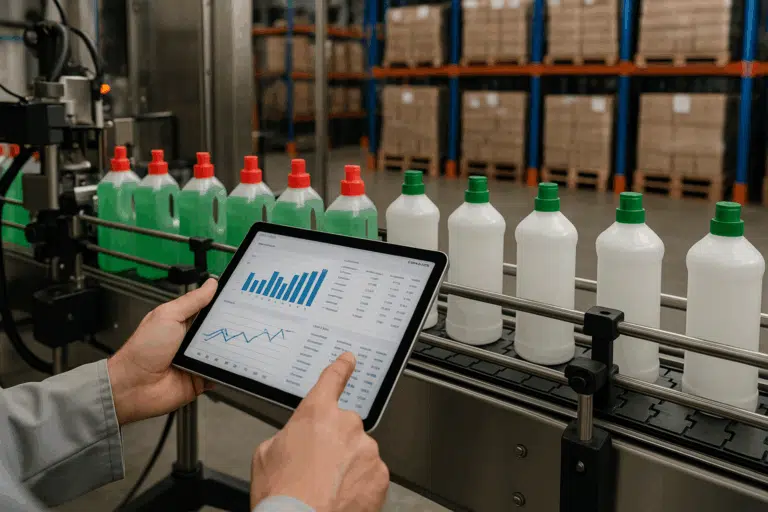An effective inventory management process flow is crucial for boosting efficiency and profitability in businesses. It involves accurate demand forecasting to determine optimal inventory levels and streamlined procurement practices for timely replenishment. Efficient inventory tracking, storage management, and data integration further optimize operations, reducing costs and maximizing profits.
Table of Contents
ToggleUnderstanding Inventory Management
Inventory management refers to the systematic control and supervision of a company’s stocked goods. It entails understanding the entire lifecycle of inventory, from the procurement of raw materials to the final sale of finished products.
The primary goal is to strike a delicate balance between having enough inventory to meet customer demand and avoiding excess stock that ties up capital and incurs holding costs. Understanding inventory management involves analyzing demand patterns, setting reorder points, and implementing efficient storage and tracking systems. It also requires aligning inventory levels with sales forecasts and market trends, ensuring smooth operations, reduced stockouts, and improved customer satisfaction.
Effective inventory management not only minimizes financial risks but also enhances productivity, cash flow, and overall business performance.
The Importance of Effective Inventory Management
Effective inventory management is of paramount importance for businesses across all industries. It plays a critical role in optimizing operational efficiency, reducing costs, and maximizing profitability.
By maintaining the right inventory levels, companies can meet customer demands promptly, minimize stockouts, and ensure timely order fulfillment. This, in turn, fosters customer satisfaction and loyalty. Additionally, efficient inventory management helps businesses free up valuable working capital that would otherwise be tied up in excess stock, enabling them to invest in growth initiatives and seize new opportunities.
Moreover, it minimizes the risk of obsolete inventory, reducing waste and improving sustainability. Through accurate demand forecasting, streamlined procurement, and optimized inventory tracking, businesses can gain valuable insights into their supply chain, enabling data-driven decision-making and enhancing overall competitiveness in the market. In essence, effective inventory management acts as a strategic asset, enhancing business agility, financial health, and long-term success.
The Inventory Management Process Flow
The inventory management process flow is a critical aspect of any business that deals with goods and products. It’s the lifeblood that ensures efficiency, cost control, and ultimately, profitability. Understanding this flow is the first step towards mastering inventory control and optimizing your supply chain.
The process flow of inventory management involves several key stages, each contributing to the smooth operation of your business. From the initial purchase of goods to their storage, usage, and eventual reordering, each step is crucial in maintaining optimal inventory levels.
Incorporating automation into this process can significantly enhance efficiency, reducing the risk of human error and freeing up valuable time for other business operations. Furthermore, accurate forecasting based on historical data can guide your reordering process, preventing overstocking or understocking situations.
In the following sections, we’ll delve deeper into each stage of the inventory management process flow, providing insights into best practices and techniques for effective inventory control.
Initial Purchase and Storage
The inventory management process flow begins with the initial purchase and storage stage, where businesses procure raw materials or finished goods to fulfill customer demands.
This phase involves careful vendor selection, negotiation, and purchase order generation. Upon receipt, the inventory is properly inspected, counted, and stored in designated warehouse locations. Accurate recording of each item’s details, such as quantity, date of receipt, and cost, is crucial for seamless inventory tracking and subsequent stages of the process.
Usage and Tracking
Once the inventory is in storage, the usage and tracking phase comes into play. This involves monitoring the movement of goods, both within the warehouse and during their transportation to various locations.
Barcode scanning, RFID technology, or other tracking systems are employed to record inventory movement in real-time. This data helps maintain accurate inventory records, enables timely replenishment decisions, and reduces the risk of stockouts or overstocking. Inventory levels are regularly updated, and any discrepancies are promptly investigated and resolved, ensuring the availability of stock when needed.

Reordering and Forecasting
The reordering and forecasting stage is critical for maintaining optimal inventory levels and meeting customer demands efficiently.
Based on historical sales data, market trends, and demand forecasting techniques, businesses identify when and how much to reorder. Reorder points and order quantities are set to trigger procurement when inventory reaches a certain level.
Effective communication with suppliers ensures timely delivery, reducing lead times and potential stockouts. Regular analysis and adjustment of forecasting models enhance accuracy and minimize inventory carrying costs, making the process more responsive to dynamic market conditions.
Key Techniques in Inventory Management
Inventory Control
Inventory control is a fundamental technique in inventory management that involves monitoring and regulating the levels of stock to strike a balance between supply and demand.
This technique includes setting minimum and maximum stock levels, establishing reorder points, and implementing safety stock policies. By constantly evaluating inventory levels and aligning them with sales forecasts, businesses can optimize working capital, minimize carrying costs, and ensure timely order fulfillment.
Stock Review
Stock review is a systematic evaluation of inventory levels to determine the quantity of goods to be ordered or produced.
This technique involves periodic assessments of stock on hand, incoming orders, and sales data. Regular stock reviews enable businesses to adjust their procurement decisions, avoid stockouts, and identify slow-moving or obsolete items that may need special attention or liquidation strategies.
Cycle Counting
Cycle counting is a continuous and periodic counting process of a small subset of inventory items throughout the year. Unlike traditional physical inventory counts that halt operations, cycle counting allows businesses to maintain ongoing operations while ensuring inventory accuracy.
By selecting a representative sample of items and rotating the items being counted, businesses can efficiently identify and correct discrepancies between recorded inventory levels and physical counts, improving data accuracy and operational efficiency.
ABC Analysis
ABC analysis is a classification technique that categorizes inventory items based on their relative importance in terms of value or demand. Items are grouped into three categories: A, B, and C. Category A includes high-value or high-demand items that require closer monitoring and stricter inventory control.
Category C comprises low-value or low-demand items, requiring less stringent management.
This technique helps businesses allocate resources efficiently, focus on critical items, and optimize inventory management efforts.
Just-in-Time System
The Just-in-Time (JIT) system is a popular inventory management technique that aims to minimize inventory levels by receiving goods only when they are needed for production or sale.
This approach requires close coordination with suppliers to deliver materials or products at the precise moment they are needed. JIT helps reduce holding costs, minimize waste, improve cash flow, and increase overall operational efficiency, making it particularly advantageous for businesses with streamlined supply chains and reliable suppliers.
FIFO and LIFO
FIFO (First-In-First-Out) and LIFO (Last-In-First-Out) are inventory valuation methods used to track the cost of goods sold and the value of remaining inventory. FIFO assumes that the first items purchased are the first to be sold, while LIFO assumes the last items purchased are the first to be sold.
These methods can have significant impacts on financial reporting and tax implications, and businesses may choose one over the other based on their specific needs and industry practices. FIFO typically results in lower cost of goods sold during periods of rising prices, while LIFO may have tax benefits during inflationary periods.
The Role of Automation in Inventory Management
Automation plays a pivotal role in modern inventory management, revolutionizing the way businesses handle and control their stock.
By leveraging advanced technologies such as barcode scanning, RFID, and inventory management software, automation streamlines inventory-related processes and enhances overall efficiency. Automation enables real-time tracking of inventory movement, reducing the likelihood of errors, stockouts, or overstocking. It also optimizes order processing, enabling faster fulfillment and better customer service.
Additionally, automated systems can analyze historical data and market trends to forecast demand accurately, enabling businesses to make informed decisions about procurement and inventory levels.
With automation handling routine tasks, employees can focus on more strategic activities, fostering innovation and improving productivity. The role of automation in inventory management empowers businesses to maintain leaner inventory, reduce carrying costs, minimize waste, and ultimately enhance profitability and competitiveness in the market.
Real-World Application: Case Studies
- Walmart: As one of the world’s largest retailers, Walmart is renowned for its sophisticated inventory management systems. The company utilizes advanced technologies to optimize inventory levels, manage stock replenishment, and ensure products are readily available for customers in its vast network of stores.
- Amazon: Amazon, a global e-commerce giant, heavily relies on inventory management to manage its vast selection of products across multiple warehouses. The company’s advanced logistics and inventory control systems enable it to offer fast and efficient order fulfillment to customers worldwide.
- Toyota: Toyota, a leading automotive manufacturer, is known for its successful implementation of just-in-time (JIT) inventory management. The JIT system allows Toyota to minimize inventory and reduce production lead times, resulting in cost savings and increased efficiency.
- Coca-Cola: The Coca-Cola Company utilizes sophisticated inventory management systems to ensure its beverages are consistently available to consumers worldwide. This involves managing production schedules, distribution channels, and inventory levels across its extensive supply chain.
- Apple: Apple, a technology and electronics giant, employs efficient inventory management techniques to handle its diverse product portfolio. By carefully managing the supply of components and finished goods, Apple can meet consumer demand and maintain high levels of product availability.
Common Challenges in Inventory Management and How to Overcome Them
Inventory management comes with its fair share of challenges that businesses must address to maintain smooth operations and maximize profitability. One common challenge is maintaining accurate inventory records, which can be overcome by implementing modern inventory tracking systems, such as barcode scanning or RFID technology, to minimize human errors and discrepancies.
Another challenge is inventory obsolescence, where items become outdated or unusable over time. To tackle this, businesses can adopt regular demand forecasting and adjust procurement decisions to minimize excess stock. Inventory shrinkage due to theft, damage, or mismanagement is another hurdle, which can be mitigated by implementing strict security measures, conducting regular audits, and training employees on proper inventory handling procedures.
Additionally, managing inventory across multiple locations or in a complex supply chain can be challenging, but integrating inventory management software and real-time data sharing between locations can help improve visibility and coordination. By proactively addressing these challenges, businesses can enhance their inventory management practices, reduce operational inefficiencies, and ultimately drive greater profitability.
Conclusion
Effective inventory management is a cornerstone of success for businesses across various industries. By understanding the inventory management process flow and applying key techniques like inventory control, cycle counting, and Just-in-Time systems, companies can optimize their inventory levels, reduce costs, and enhance customer satisfaction.
Automation plays a crucial role in streamlining inventory-related tasks, improving data accuracy, and enabling efficient decision-making.
However, real-world applications reveal that even the most prominent companies face challenges in inventory management, such as maintaining accuracy, handling obsolescence, addressing shrinkage, and managing complex supply chains. To overcome these obstacles, businesses must adopt modern technologies, implement robust security measures, and continuously improve their inventory management practices.
By doing so, they can unlock the full potential of inventory management and propel their organizations towards increased efficiency, profitability, and sustained growth in the dynamic marketplace.
FAQs
What is the role of supply chain in inventory management?
The role of the supply chain in inventory management is to ensure a smooth flow of goods from suppliers to end consumers, while optimizing inventory levels at each stage. Effective supply chain management helps in reducing lead times, minimizing stockouts, and improving overall efficiency, ultimately leading to cost savings and improved customer satisfaction.
How can inventory levels affect my business profitability?
Inventory levels can significantly impact business profitability. Excessive inventory ties up valuable working capital, increases holding costs, and can lead to obsolescence. On the other hand, inadequate inventory levels may result in lost sales opportunities and dissatisfied customers. Maintaining optimal inventory levels through accurate demand forecasting and efficient inventory management practices can boost profitability by reducing costs and improving revenue generation.
How does a Just-in-Time system improve inventory efficiency?
A Just-in-Time (JIT) system improves inventory efficiency by producing or ordering goods only when they are needed for production or sale. This reduces the need for large stockpiles of inventory and minimizes carrying costs. JIT also helps in identifying inefficiencies in the production process and streamlining operations, leading to reduced waste and improved productivity.
What are the benefits of using automation in inventory management?
The benefits of using automation in inventory management are numerous. Automation improves data accuracy, streamlines inventory tracking, and enables real-time monitoring of inventory levels. It also enhances order processing, minimizes manual errors, and allows businesses to make data-driven decisions promptly, leading to increased efficiency and reduced operational costs.
How does cost control relate to inventory management?
Cost control is closely related to inventory management as it involves optimizing the expenses associated with holding and managing inventory. By implementing efficient inventory control techniques, businesses can reduce excess inventory, carrying costs, and potential wastage, leading to better cost management and improved financial performance.
What is the difference between FIFO and LIFO in inventory management?
The main difference between FIFO (First-In-First-Out) and LIFO (Last-In-First-Out) in inventory management is the method used to value inventory. FIFO assumes that the oldest inventory items are sold first, while LIFO assumes that the most recently acquired items are sold first. This affects the cost of goods sold and the value of remaining inventory, which can have tax and financial reporting implications.
How can forecasting improve my inventory management process?
Forecasting can significantly improve the inventory management process by providing insights into future demand trends. Accurate forecasting allows businesses to anticipate customer demand, adjust inventory levels accordingly, and optimize procurement and production decisions, leading to reduced stockouts, minimized excess inventory, and improved overall inventory efficiency.
What are the common challenges in implementing inventory control techniques?
Common challenges in implementing inventory control techniques include maintaining accurate records, handling obsolescence, managing shrinkage, and coordinating inventory across multiple locations or supply chain partners. Businesses must address these challenges through technology adoption, security measures, regular audits, and better communication and collaboration with suppliers and partners.
How can inventory management software enhance my business operations?
Forecasting can significantly improve the inventory management process by providing insights into future demand trends. Accurate forecasting allows businesses to anticipate customer demand, adjust inventory levels accordingly, and optimize procurement and production decisions, leading to reduced stockouts, minimized excess inventory, and improved overall inventory efficiency.
Can you provide real-world examples of successful inventory management?
Real-world examples of successful inventory management can be seen in companies like Toyota, Dell, and Walmart. Toyota’s just-in-time production system revolutionized the automotive industry, Dell’s build-to-order approach minimized inventory and maximized efficiency, and Walmart’s advanced inventory management system allowed them to maintain low costs and high product availability, contributing to their market leadership.



























